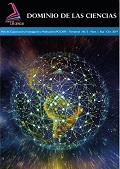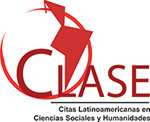A study of the social profile of indigenous people aged 5 to 14 years old in Ecuador: Analyzing and understanding key aspects
DOI:
https://doi.org/10.23857/dc.v5i1.1061Palabras clave:
indigenous minors-, Ecuadorian indigenous and education, multidimensional statistical analysisResumen
The objective behind this study was to investigate the indigenous people, aged 5 to 14 years old, in Ecuador in order to know about their conditions regarding sociodemographic and socioeconomic statuses and aspects concerning access to technology. It was also examined the implications these conditions may have to access education among indigenous minors, and the activities they perform in society. In order to achieve the objectives of this study, a descriptive analysis and a multidimensional statistical analysis were carried out. Available data from the National Survey of Employment, Unemployment and Underemployment of Ecuador (ENEMDU), conducted by the National Institute of Statistics and Censuses (INEC) in 2016, was utilized as the main source of information. The descriptive analysis showed the frequencies and the percentages of the variables that were explored by this study. The multidimensional statistical analysis was employed with the aim of showing the main and the most important criteria of differentiation and classification in different clusters of people under study. The method employed was the multiple correspondence analysis, which showed the criteria of differentiation and a hierarchical clustering that defined the clusters of people based on their common characteristics.
Citas
Athanasiadis, I. (1995). Correspondence Analysis and Hierarchical Classification (pp. 51-56). Athens: New Technologies Editions.
Benzí©cri, P. (1992). Correspondence Analysis Handbook. New York: Dekker.
Bureau of Democracy, Human Rights & Labor. (2011). Ecuador: Country reports on
human rights practices. Retrieved February 7, 2018 from https://www.state.gov/documents/organization/186722.pdf
Bureau of Democracy, Human Rights & Labor. (2006). Ecuador: Country reports on
human rights practices. Retrieved February 5, 2018 from https://www.justice.gov/sites/default/files/eoir/legacy/2013/06/07/ecuador_6.pdf
Instituto Nacional de Estadística y Censos – INEC. (2015). Encuesta Nacional de Empleo, Desempleo y Subempleo - ENEMDU. Quito, Ecuador.
Olivier, M. (2008). The analysis of quantitative data, Transl. Athanasiadis, I. (pp.86-88). Athens: Topos.
Papapostolou, I., Papapostoulou, K. & Stefos, E. (2013). Educational Research. From Qualitative to Quantitative analysis. p.178. Rhodes: Evdimos Editions.
Papapostolou, I. & Stefos, E. (2013). Qualitative analysis on pedagogical research. Methodological approaches. In I. Papapostolou (Ed.), Educational activities. Teaching Interventions in Secondary Education. pp.244-251. Rhodes: Evdimos Editions.
Stefos, E. & Koulianidi, G. (2016). Nutrition Data Analysis Using R: Applications in Higher Education. Health Sciences Research, Vol. 3, No. 1, 2016, pp. 10-16.
Stefos, E. & Efstathiou, I. (2013). Quantitative analysis of the data of the School of Trianta during the period of 1906-1916. In I. Papapostolou (Ed.), Educational activities. Teaching Interventions in Secondary Education. pp.29-57. Rhodes: Evdimos Editions.
Stefos, E. & Papapostolou, I. (2013). Research Methodology. Processes and suggestions. p.406. Rhodes: Evdimos Editions.
Stefos, Ε., Athanasiadis I., Gialamas, B. & Tsolakidis, C. (2011). The Use of New Technologies and the Project Method in Teaching Statistics: A Case Study in Higher Education. HMS i JME, Volume 3. 2010-2011. pp.84-100.
World Bank Group. (2015). Indigenous Latin America in the twenty-first century: The first
decade. Washington DC: International Bank for Reconstruction and Development / The World Bank.
Descargas
Publicado
Cómo citar
Número
Sección
Licencia
Authors retain copyright and guarantee the Journal the right to be the first publication of the work. These are covered by a Creative Commons (CC BY-NC-ND 4.0) license that allows others to share the work with an acknowledgment of the work authorship and the initial publication in this journal.







